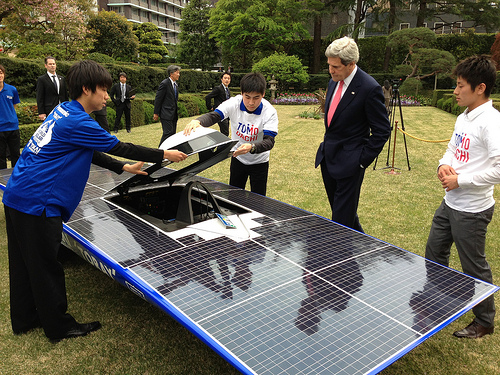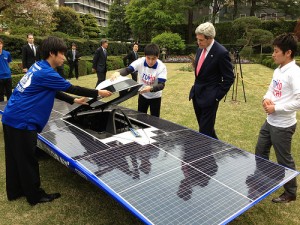
Engagement: What does it Mean for Public Diplomacy?
In recent years, diplomatic circles have been relying on the term “engagement” to describe various communication and public diplomacy activities with foreign publics. The term is used almost universally in government, the military, academia, corporations and think tanks to describe a range of practices designed to influence or persuade foreign audiences.
Exploring the sudden shift to “engagement” as a preferred term by these circles, Dr. Nick Cull wrote in 2009:
The term engagement has much to commend it. It is not the term public diplomacy. It is already used in slightly different ways in the worlds of marketing and the military and can therefore be assumed to fall reassuringly on the ears of both those constituencies. It has already gained currency among NGOs and other practitioners of international communication.
But missing from the discourse about engagement and its attractiveness as a term is a substantial discussion of exactly what it means. Since “engagement” is used so commonly without explanations of what it actually entails, it appears to have become little more than a buzzword developed to encompass various activities that are otherwise difficult to succinctly describe.

State Department Caption: U.S. Secretary of State John Kerry admires a solar-powered car built by members of the TOMODACHI Initiative youth “engagement” program in Tokyo, Japan
Let’s look at a few examples of how the term engagement has been used.
When presenting statistics about social media activities undertaken by the State Department’s Center for Strategic Counterterrorism Communications, Ambassador Alberto Fernandez described the number of “engagements” the CSCC’s digital outreach team had made that year as in the thousands. Explaining what an engagement is, Fernandez stated that engagements “consist of written text posted to online forums, Facebook, or the comments sections of media Web sites.” So does each post the CSCC makes in a forum count as an “engagement?” Does each post on Facebook count as an engagement? If so, this appears to set a low bar for what is considered engagement.
In another case, the military uses the term to describe personal relationships and building partner capacity. However, engagement doesn’t always imply benign activities either—as when the military uses the word “engage,” it is often in the context of destroying a target.
If anything, using the term engagement can sometimes provide the user with a perceived ability to forgo one of the most difficult parts of public diplomacy—that is demonstrating metrics which indicate whether or not one’s efforts are succeeding at influencing the target audience. In other words, the user of “engagement” may feel as though they needn’t actually explain the effects of their activities because they are “engaging” by nature of the word.
This is why analyzing the content of engagement is vital. Is a forum post engaging? Is a billboard engaging? Is a TV advertisement engaging? This can be difficult to determine, and cannot be assumed.
What practitioners and policymakers should understand is that core of public diplomacy is not really about undefined “engagement”—it is about building relationships.
By focusing on relationship-building, and eliminating engagement from the PD lexicon, practitioners and policymakers may begin to better employ the thinking that is required for better public diplomacy. Rather than speaking about PD in abstract terms, emphasizing relationship-building forces those participating in the PD debate to consider the types of activities that are necessary to gain influence. Rather than counting one-off twitter postings as engagement, practitioners should focus on substantive, comprehensive and continuing dialogue.
One of the biggest problems in public diplomacy is that few understand what it is, and the terminology itself doesn’t help. Soft power, public diplomacy, and engagement all need to be explained in order to be understood. These terms have no immediate recognition like war, peace, freedom or competition. For this reason, perhaps “building relationships” should be used more often by those exploring or explaining the subject.
In the end, “building relationships” gets to the core of how public diplomacy should be geared, and serves to remind practitioners of the types of efforts needed to exert non-coercive influence.







[…] Engagement: What does it Mean for Public Diplomacy? Matthew Wallin Missing in the discourse about engagement and its attractiveness as a term is a substantial discussion of exactly what engagement means. Since “engagement” is used so commonly without explanations of what it actually entails, it appears to have become little more than a buzzword developed to encompass various activities that are otherwise difficult to succinctly describe. […]
[…] Engagement: What does it Mean for Public Diplomacy? […]
[…] Wallin of the American Security Project posed an interesting question in a recent blog post titled “Engagement: What does it mean for public diplomacy?” This question touched a nerve for me, because there are no ready definitions for the term – […]
[…] USC Center on Public Diplomacy discussing a recent blog post by ASP’s Matthew Wallin which challenged the use of the term “engagement” in public diplomacy […]
[…] ASP’s Matthew Wallin outlined in Engagement: What does it Mean for Public Diplomacy?, “engagement” needs to be better defined so that its effectiveness can be measured. The […]
[…] with leading America’s efforts to “inform, influence, and engage” foreign publics in support of foreign policy objectives, the Under Secretary position comes with […]